Blackfoot Physics
- 320pages
- 12 heures de lecture
Cet auteur, à l'origine un physicien théoricien, étend ses recherches bien au-delà des frontières de la science. Ses intérêts vont de la psychologie de C. G. Jung et de l'art à des aspects culturels plus larges, y compris la culture amérindienne. Ses ouvrages explorent les profondes connexions entre la théorie quantique, le chaos et la synchronicité, s'appuyant souvent sur les idées de David Bohm, avec lequel il a collaboré. En fondant le Pari Center for New Learning en Italie, il favorise davantage l'étude interdisciplinaire et la recherche de nouvelles perspectives.
